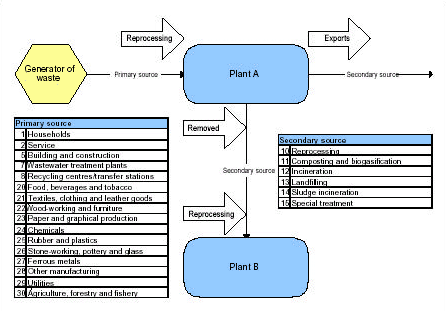|
| Front page | | Contents | | Previous | | Next |
Waste Statistics 2001
1 Introduction
The ISAG (Information System for Waste and Recycling)
The ISAG was used for the first time in 1993. The 2001 reports are the ninth consecutive reports.
The ISAG is based on statutory registration and reporting from Danish waste treatment plants for all waste entering
or leaving the plants. Information concerning waste in the previous year must be reported to the Danish
Environmental Protection Agency each year, no later than 31 January.
In order to avoid double registration, it is important to distinguish between waste from direct (primary) sources
and waste from plant (secondary) sources. The principles behind the ISAG registration are shown below.

The Danish EPA carries out quality assurance of the information it receives and collects additional information from
sector organisations and other sources. Each year the Danish EPA prepares a publication called Waste Statistics,
which gives an overview of waste composition and waste arisings in Denmark.
The publication also provides an outline of how much of the total amount of waste has been recycled, incinerated
and landfilled. Information is analysed between commercial sources and waste types.
New methods
Waste Statistics 2001 is the first statistics publication containing data reported according to the new rules set out in
the Danish Statutory Order on Waste (Statutory Order No. 619 of 27 June 2000). The new rules have meant a
number of changes to the ISAG. Amongst other things, the number of commercial sources has been changed, so
that for 2001 it is possible to analyse industrial waste between 11 different sectors. In addition, packaging waste
has been added as a new waste type.
The principles for distribution of waste received from recycling centres/transfer stations for the two waste fractions
"bottles & glass" and "paper & cardboard" have likewise been changed compared to the years 1994 to 2000.
"Paper and cardboard" and "bottles and glass", registered as "industrial and commercial waste", were previously
redistributed to the source "institutions, trade and offices" by the ISAG secretariat. The ISAG secretariat has
deemed that a redistribution of these waste types to the source "households", will provide a truer and more realistic
view of waste composition. See Annex 2 for a more detailed explanation of the principles for the redistribution.
In the 2001 statistics, mineralisation of sludge is for the first time included with a dry matter content of 20 per cent.
Thus mineralised sludge amounts are incorporated into the statistics with the same dry matter content as the
remaining sludge. In previous years dry matter content for sludge for mineralisation has been 1.5 per cent.
Please note that the changes mentioned above in reporting of data in 2001, mean that care should be taken when
comparing 2001 figures with waste arisings at sector level from previous years.
Reading guide
Waste Statistics 2001 follows almost the same structure as in previous years' statistics; Chapter 2 describes general
developments in waste generation, whereas Chapter 3 deals with recycling of waste.
Chapter 4 deals with generation and treatment of hazardous waste, and in Chapter 5 developments in imports and
exports are described, both for ordinary waste and waste subject to mandatory notification.
In Chapter 6, a detailed description of developments in waste arisings and treatment of waste from different
sources is given. Furthermore, figures are compared to targets for treatment in 2004 in the Danish Government's
Waste Management Plan 1998 - 2004, Waste 21.
Chapter 7 gives an outline of Danish incineration plants and landfills.
In Chapter 8, a baseline projection of developments in waste generation up to 2020 is presented. The baseline
projection is supplemented with a projection including the effects of Waste 21 initiatives on the distribution of waste
between treatment options.
Conclusions
Reports to the ISAG for 2001 cover 402 plants owned by 295 enterprises. In 2000, reports covered 407 plants
owned by 299 enterprises.
The following statements summarise waste generation in 2001:
- Total waste generation in 2001 amounted to 12,768,000 tonnes, which is 2 per cent less than in 2000.
Reductions are primarily due to the fact that sludge for mineralisation is included with a dry matter content of
20 per cent compared to 1.5 per cent in previous statistics. This means that sludge amounts have been
reduced by 808,886 tonnes.
- If amounts of residues from coal-fired power plants are kept apart from statistics, there has been a decrease
in waste generation of 298,000 tonnes, corresponding to 3 per cent of the 2000 figure.
- The overall rate of recycling amounted to 63 per cent, which is one per cent less than the overall recycling
target of 64 per cent for 2004. Since sludge has a high recycling rate, the reduction in sludge amounts of
808,886 tonnes has also caused the total recycling rate to fall.
- Waste amounts incinerated accounted for 25 per cent, which is one per cent more than the overall target of
24 per cent for incineration in 2004.
- Waste going to landfill amounted to 10 per cent, which is better than the overall landfill target for 2004 of a
maximum of 12 per cent for landfilling.
- Targets for treatment of waste from the different sectors, however, are still not complied with – too little
waste from households and the service sector is recycled, and too much waste from industry is led to landfill.
| Front page | | Contents | | Previous | | Next | | Top |
Version 1.0 January 2004, © Danish Environmental Protection Agency
|